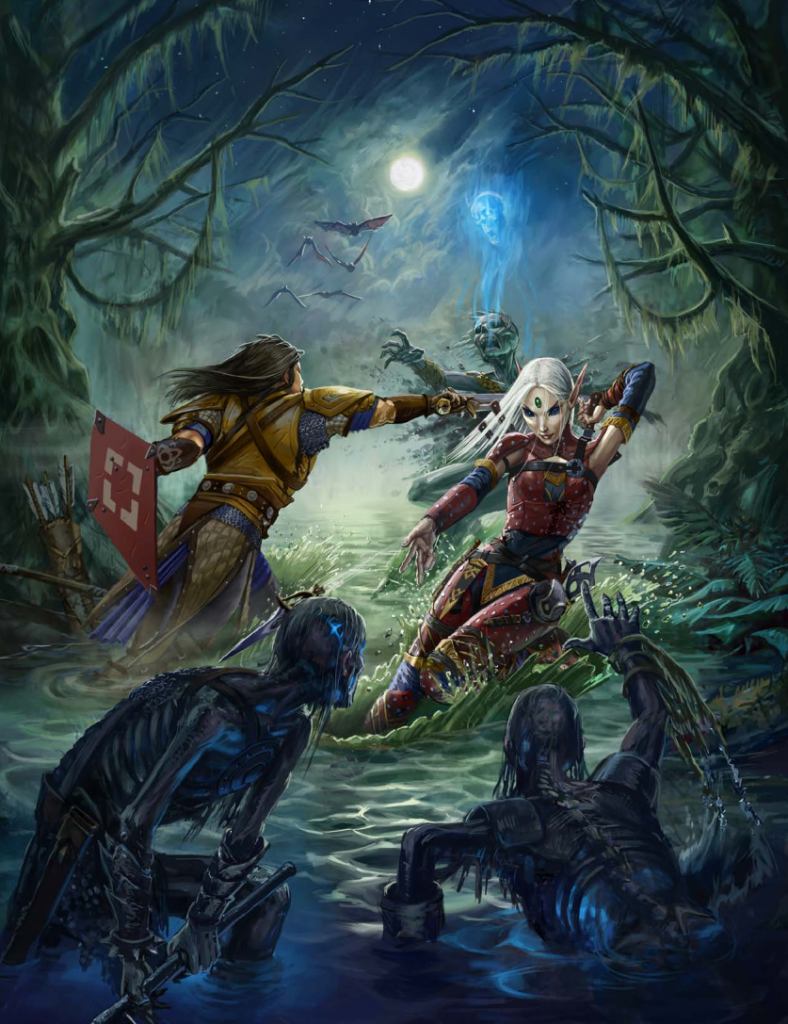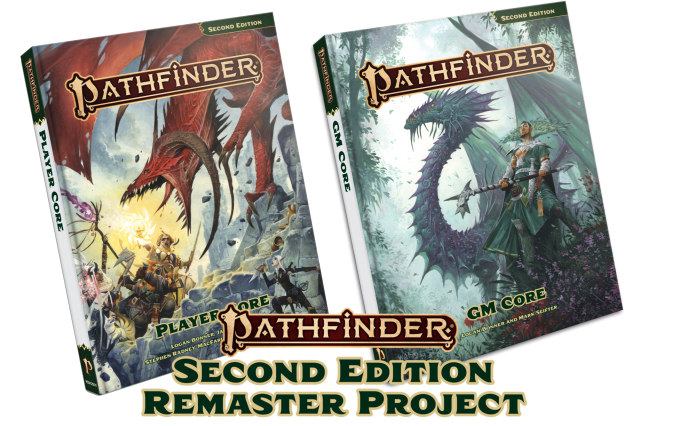Pathfinder Second Edition Remastered is a bit of a curious thing. In the TTRPG space while the term remaster itself has not appeared so regularly over the years it has in function through different labels: Revised editions or Reprinted Rulebooks that contain errata’d material, or Anniversary editions of old out of print games act in the same way as a remaster of a video game would with fixing various bugs or adding highly requested quality of life changes. And while not out of the ordinary for an updated version of an RPG to be released a couple of years after its original release, the circumstances for this remaster are what I find to be intriguing in addition to the updates and changes it makes which requires a dive into Pathfinder’s and it’s creator Paizo’s history.

Pathfinder by Paizo Inc. and TTRPG industry titan Dungeons & Dragons have been linked together since Pathfinder’s creation. Pathfinder originally began life in 2007 as a line of periodicals as a replacement for the then-discontinued Dungeon and Dragon magazines. It wasn’t until a couple of years later that we saw the first edition of Pathfinder, simply titled Pathfinder Roleplaying game.
Similar to how the periodical was conceived in reaction to WOTC, first edition Pathfinder was created as a result of the often-maligned fourth edition of D&D. Where fourth edition made drastic changes to the D&D formula Pathfinder would instead seek to refine 3.5 shaving off perceived rough edges broadly compressing a lot of superfluous skills into others, such Listen and Spot becoming Perception, Balance and Tumble becoming Acrobatics, Hide and Move Silently to Stealth, amongst others.
This was all legally possible due to the Open Game License or OGL that Dungeons & Dragons 3.5 was released under which allows for the use and sharing of materials classified as Open Gaming Content as well as granting “Permission to copy, modify and distribute the files collectively known as the System Reference Document (“SRD”) is granted solely through the use of the Open Gaming License, Version 1.0a.” Under the OGL you could create and sell content you’ve created utilizing non-trademarked material or things that aren’t considered to be “Product Identity” (product and line names, artwork, and some spell and ability names). So for example you cannot have Tenser’s Floating Disk, as Tenser is a character owned by Wizards of The Coast and as such not Open Game Content, but you can have the spell Floating Disk.
Pathfinder would find immediate success critically and commercially. Winning numerous ENnie Awards including Product of the Year as well as topping the sales charts throughout the next handful of years and every so often outselling Dungeons & Dragons fourth edition. Dungeons and Dragons 5th edition would then hit shelves in 2014 and soon thereafter become the juggernaut we know it as of today.

Paizo would continue along with Pathfinder releasing a staggering amount of content for the system including new classes, feats, and adventure paths. To this day you can play a game of Pathfinder and still find some new option you’ve never considered in the past. Among the additions to the Pathfinder system Paizo would show that they were not afraid to give the system a shake up with Pathfinder Unchained. Unchained would include some class revisions and importantly a Three point action economy.
Pathfinder second edition would follow suit, originally released in August of 2019 under the same OGL as Pathfinder first edition. PF2E was a significant departure from 1E. The action economy was entirely redone, doing away with full round action, standard action, swift action and move action and going for a refined version of the Unchained 3-action system and a more tactical combat system that ends up being quite reminiscent of D&D fourth edition. PF2E was quite well received; those looking for an alternative to fifth edition that offered more depth found it to be just what they were looking for. Second edition provided a solid foundation of rules for prospective Game Masters and players alike to interact and create whilst not being as overly complicated as first edition Pathfinder could get.
On December 21st of 2022 Wizards of the Coast announced that they would be updating the OGL for the newest Dungeons & Dragons edition, OneD&D. Most approached the update with some trepidation while Wizards assured that those making “Free Share-alike Content” would be able to continue to operate as they have, been content creators that do sell content using the OGL with revenue $750,000 or higher would be subject to royalties and would directly affect Paizo. Everything would come to a head a couple of weeks later on January 5th 2023 when OGL 1.1 was leaked revealing that the previously available 1.0 OGL would no “longer be authorized” and thus creators who used the 1.0 OGL to publish their works would be forced to to overhaul their games to fit the new OGL or the would no longer be able to continue selling their products.
The community backlash would stay Wizards’ hands, and while they would go on to release the 5e SRD under Creative Commons, the damage had been done. With the trust between all parties frayed and no guarantee that 1.0 wouldn’t be revoked at a future date, Paizo would announce the system-agnostic Open RPG Creative License, ORC.
New ORC license
Intended to be a “a system-agnostic, perpetual, and irrevocable open gaming license” underwent a number of revisions before the Final Version was released in June 29, 2023. There is no one person, or organization in control of the license allowing for it to be and remain immutable with no possibility for an “OGL 1.1” to happen again. How it works is that by using this license you designate what part of your works are
- Licensed Material or content that you are licensing to other creators.
- This includes all Game mechanics automatically
- Reserved Material content such as trademarks, setting, characters, artwork and music.
- You however can explicitly designate content that is automatically considered Reserved Material as Licensed Material
Turbulent Winds Of Change

In order to bring things in line with the new ORC license, Paizo would set out with the remaster to excise all OGL material and make changes where they could to have Golarion still feel like the Golarion we’ve come to know over the last decade, remaining compatible with previously released books. Not everything was able to make the cut however.
The changes made are vast and comprehensive the most notable of these are:
- Alignments no longer exist, having been replaced with Edicts and Anathema that act as behaviors that your character’s particular ethics encourage and those that violate them respectively. Edicts and Anathema are explicitly optional for most characters, with exceptions for classes like the cleric and Champion.
- Ancestries:
- Half-elves and half-orcs are now Aiuvarian and Dromaar. They are valid for all heritages, and no longer restricted into being half-human. Also includes rules for other custom mixed-ancestries.
- Aasimar and Tieflings are now Nephilim.
- Drow are completely removed from the setting being “retconned out.” Having been a popular ancestry since even before Pathfinder’s existence, this is a significant loss.
- Magic
- No more standard schools of magic where spells all belong to a single specific category.
- Spell components have been done away with.
- Wizard subclasses are still called schools, but they refer to actual establishments.
- Huge changes to monsters with more coming with the soon-to-be-released Monster Core book, but what caught my eye the most were:
- Chromatic and Metallic dragons being replaced with Dragons that reflect the traditions of magic.
- A number of fan-favorite monsters are likely not going to be included in the new Monster Core such as owlbears, bulettes and aboleths (who’ve already received a name change and may need further changes to avoid any legal trouble).

It’s regrettable that the catalyst for these changes were Wizards of the Coast’s overreach with the OGL, but the changes themselves on the whole are for the betterment of the system and in carving out a further distinct identity for Pathfinder, though they may not quite stick the landing completely.
Gameplay-wise not much has changed you can still use all the previous books released before the remaster and it will work just fine. Everything is still running on the second edition system. There are a few verbiage changes with the Flat-Footed condition being renamed to Off-Guard and Attacks of Opportunity being changed to Reactive Strikes. Both are functionally identical to their pre-remaster counterparts, just with far less OGL reliant wording. Some classes received small quality of life touch ups like the warpriest which is now no longer spread thin attribute-wise; other classes like the wizard received more noteworthy changes.
Many classic spells have either been renamed or replaced entirely. Magic Missile has become Force Barrage and the Magus’ trusty Shocking Grasp was replaced with Thunderstrike. Compared to the former Schools of Magic, the wizards’ new Arcane Schools Spell list makes for a much more limited choice of spells in large part due to the somewhat arbitrary nature of what spells are deemed appropriate for which school. These changes, while substantial, do not make this Pathfinder 2.5. The way you play the game remains the same. Even the larger changes do not change how the fundamentals of how each class plays. You’re still rolling the big d20 and other polyhedrals.
The Verdict:
Change is not always a bad thing and in the TTRPG space change is necessary for the long term health of the hobby. I think the foundation of Pathfinder second edition is solid, most classes are designed in a satisfying way, it’s still quite easy to GM for and quite fun to play. As of Player Core 1’s release I don’t feel I can give a wholehearted recommendation of the remaster to longtime players. To new players interested in a fantasy TTRPG that isn’t Dungeons & Dragons, the remaster is a great point of entry. The Player Core and GM Core are all laid out well and are very approachable.
Pathfinder second edition remastered is as much a building block for the future of Pathfinder (and Starfinder) as it is an updated rerelease of the original game. It represents the first major step of Paizo attempting to move out from under the shadow of Dungeons & Dragons. So while the contents of the books thus far aren’t exactly eye-catching or paradigm shifting, the potential the franchise has to carve out a more distinct identity is what I find to be the most fascinating aspect of this endeavor. It’s unlikely that we’ll see the full effects of this soon, but we are in for some exciting times in the TTRPG space.


